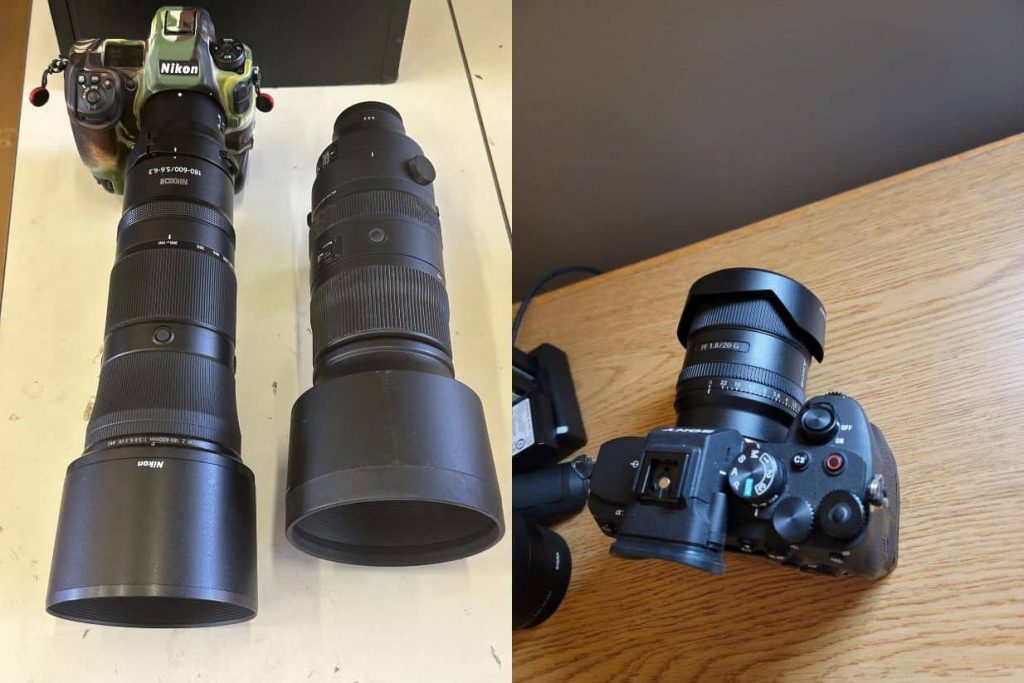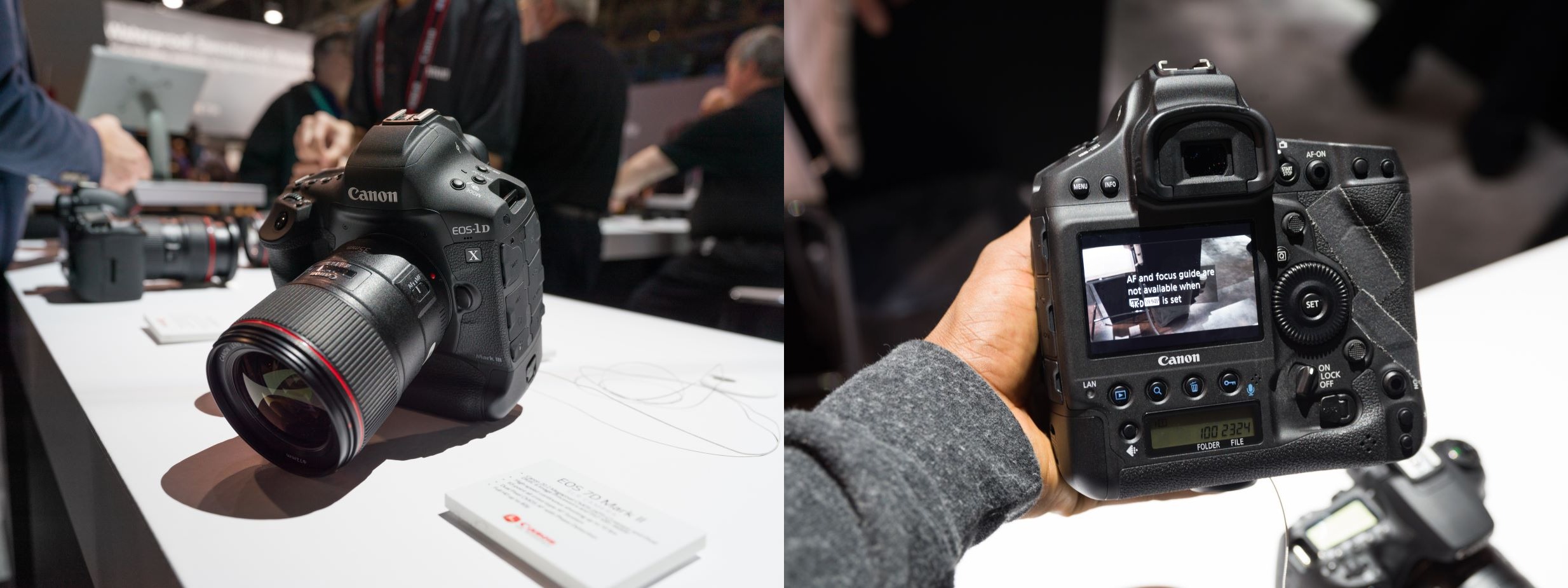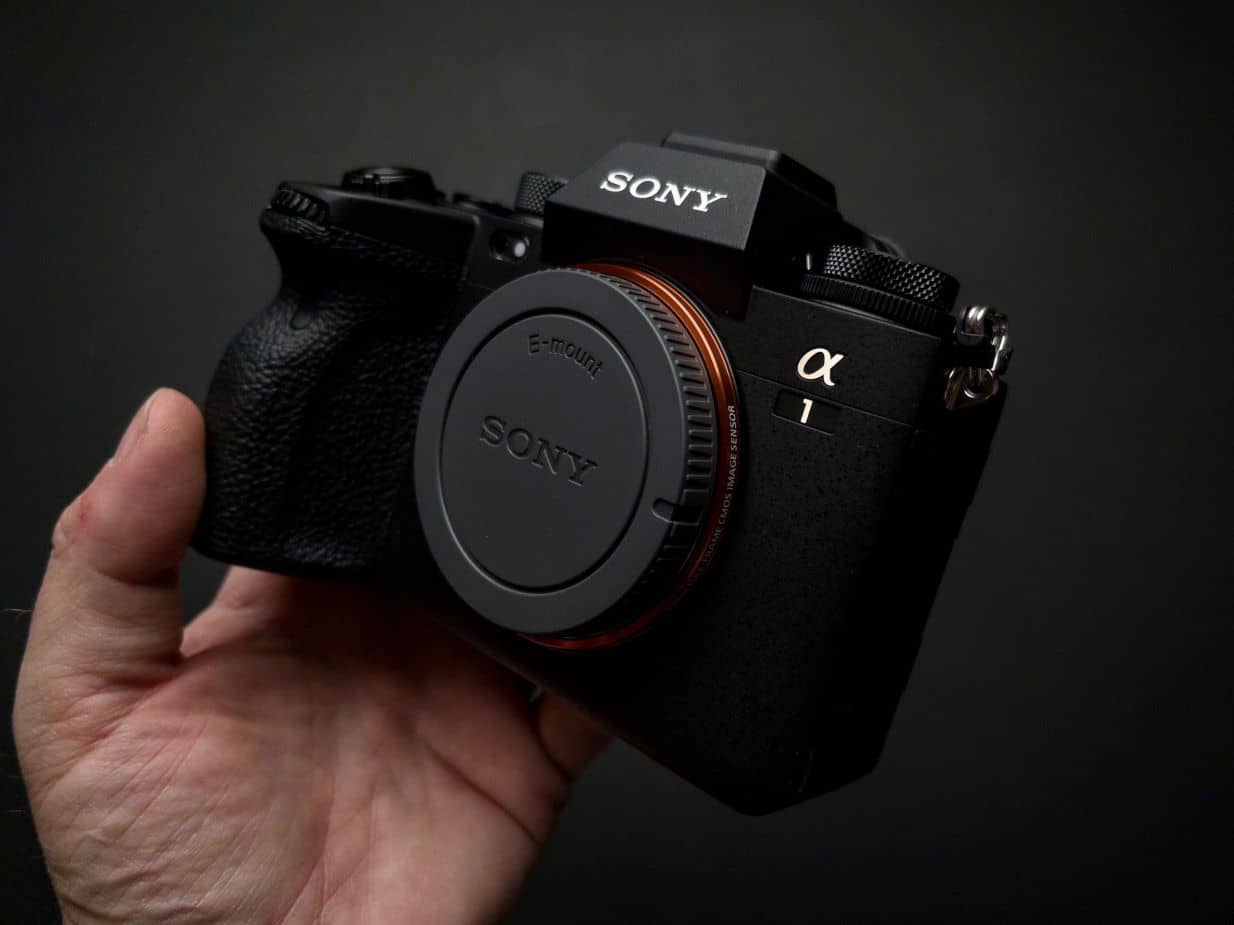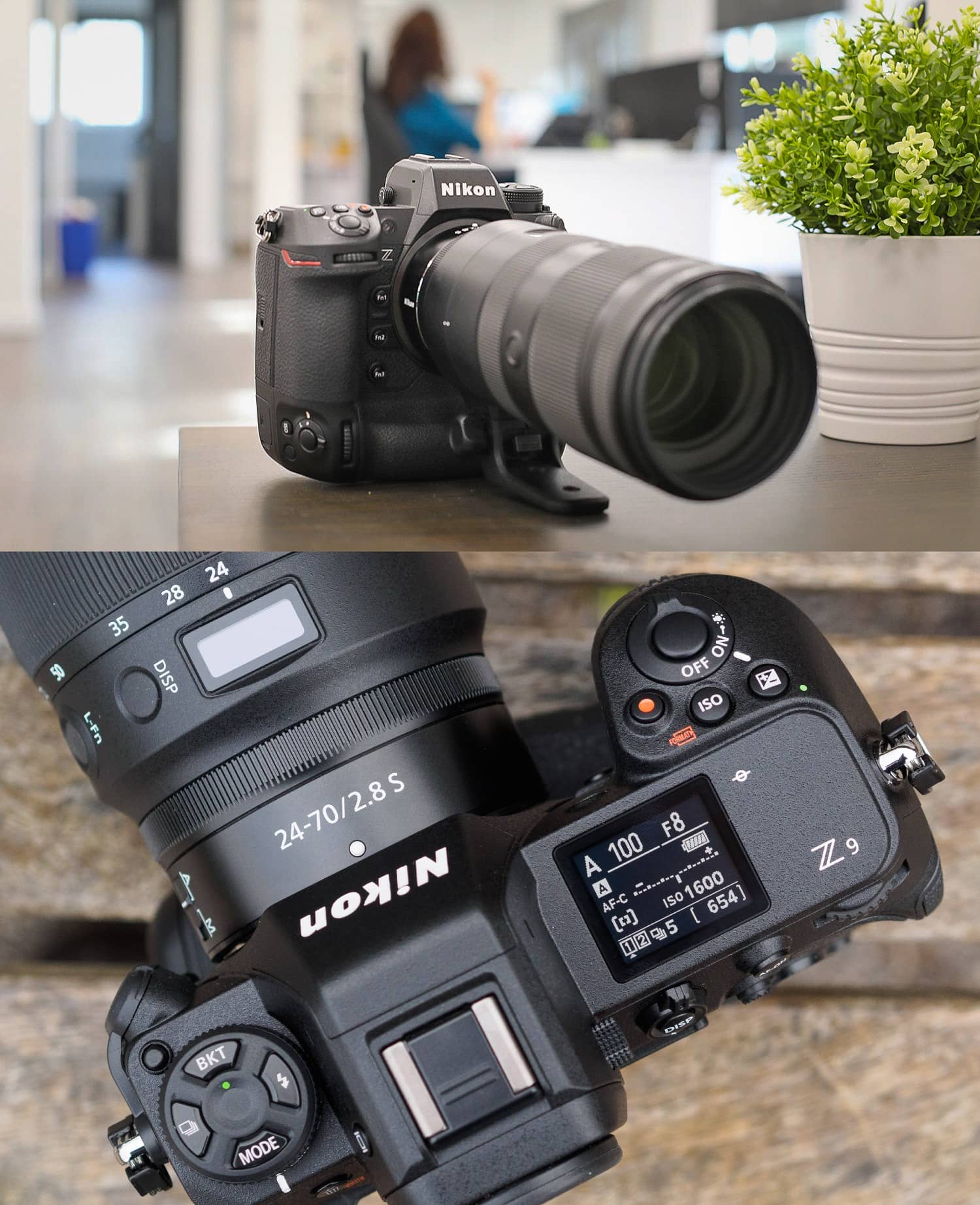Flagship professional cameras are used by photographers in war zones and by sports photographers in brightly illuminated stadiums. You’ll also see them at big events, weddings, studios, landscape photography shoots, and in the hands of reporters.
They become extensions to the arms of these professionals, and are expected to operate under extreme conditions, fulfilling advanced roles and setting endurance records to the nth degree. They can’t ever perform poorly, nor can one of these models be slow to focus or struggle in low light situations.
Priced accordingly, some of these models are large and unwieldy, but they’re also incredibly capable. As you can probably imagine, weight and heft isn’t necessarily an issue anyway, not in a professional studio or at some big event wedding or conference, not when a tripod is available. Even if a tripod isn’t part of their camera gear set up, performance is everything.
Ultimately, that aspect outweighs other considerations, including a light build. Over with a snapshot enthusiast, they can afford to sacrifice a little image quality when they want a camera that’ll slip into a pocket or purse. For professionals, well, image accuracy and color depth are the industry benchmark, always in place to satisfy demanding clients.
|
$6,496.95
|
$5,698.00
|
$6,499.00
|
$5,196.95
|
Features Camera Gurus Demand in Professional Cameras
The first factor we’re going to cover isn’t one that immediately comes to mind. Selecting the best camera for professional photography applications, you’ll need a model that offers superior ergonomics. Soft rubberized and weatherized grips over a toughened magnesium alloy body, hours of operation are made possible, even on a heavy camera, if it has a good ergonomic design.
Related to this opening attribute, a large battery pack is key. Thousands of shots can be stored if the camera has a large power capacity. Even so, a professional will likely buy a second or third power pack, ready to quickly swap out the depleted battery. Likewise, a slot for a high-capacity, high speed memory card is essential. Some of the models discussed even incorporate a second slot for full shoot redundancy.
As for the camera specs professional photographers demand, expect high-endurance mechanical shutters and toughened aperture assemblies. A full-frame CMOS sensor is also a must-have onboard feature. In line with this requirement, the image processing engine must be fast enough to process all of the color depth data and remove ISO noise. Some kind of post-processing feature is also common, processing the RAW image information, then storing it for quick retrieval.
All of this is done while shooting bursts of up 14 frames per second, combined with instant lens autofocus and exposure control. Staffers assemble, these cameras are beasts to handle, firing off bursts like a surgical strike, syncing to multiple flash modules, all while enduring the intense demands of a fast-paced, pressure cooker of a shooting environment.
Diving in, we’ve come to a consensus. Leading the pack, at least in several shooting metrics, the Nikon D6 DSLR is our opener.
Nikon D6 DSLR Professional Camera Body
A hefty magnesium alloy body is weather-sealed and coated with rubberized grips. The alloy keeps the camera as light as possible and won’t corrode, although there’s no getting away from the fact, this is a heavy camera. On closer inspection, there are dual shutter releases, one on the top of the camera, one on the bottom, close to the battery pack. Vertical shooting modes take advantage of the secondary sub-command dial and the vertical shutter release button.
As for the camera’s specs list, it’s a glowing list of top-of-the-line features. A full-frame 20.8 MP FX CMOS sensor occupies a large chunk of real estate in the rear of the camera’s innards. No matter the light conditions and speed of the shoot, this sensor captures perfect low-noise shots. An ISO that ranges from 100 to 102,400 further up its low light shooting credentials, and the EXPEED 6 image processing engine takes care of any image noise while retaining detail and color depth.
We can’t ignore the advanced autofocus system, a mechanism that instantly focuses on the smallest of detail, using its 105-point cross-type sensor to lock-in on a composition effortlessly. Lens superiority, taken from any number of Nikkor compatible lenses, takes care of other creative aspects, such as DOF (Depth of Field) strength, showcasing the subject of the shoot.
Pro photographers have the reins at all times. Modes are accessed on the densely packed command dial, which is equipped with recessed push buttons and dials, too. The rear panel is similarly decorated in numerous buttons, every one of which satisfies a key role. In the middle of this ergonomically laid out panel, the monitor resides, filled with shoot data and live view displays.
A 4K 60 fps video mode is part of the feature list. Canon cameras are more popular as video production tools, but this Nikon isn’t far behind when it comes to video footage fidelity. All-in-all, this is one of the very best professional-grade DSLR cameras you can find.
Canon EOS-1D X Mark III DSLR Professional Camera Body
It’s just too close to choose, even the past professional photographers on our team have a hard time picking between the Nikon D6 and this pro-grade flagship Canon DSLR. For starters, budding film directors have a monster of a motion picture camera in their hands, a cinematic filming device that captures footage at 5.5K.
Sure, that’s an unusual figure, but this is a photography article, not a film device review, so let’s move on, knowing Canon cameras make superb video creation tools. Equipped with a 20.1 MP CMOS sensor, an image capturing component that’s as large as a man’s palm, the Canon EOS-1D X Mark III captures fine detail in low light settings. Aiding this feature, a 4 layer low pass filter resolves hidden detail while the Digic X imaging engine reduces artifacts like moire and aliasing.
Rugged performance is another aspect altogether, with the ruggedized magnesium alloy body contributing user toughness and weather sealing. To us camera folk, though, it’s a bulky product, one that’ll require deft handling. Part of that bulk comes down to the vertical grip, which contains a battery that looks strong enough to power a small country. Otherwise, leaving construction behind, full vertical shooting controls and a thumb sensor for manually selecting AF points are all located down here. Pulling back a little, multiple LCD panels and a live view monitor are in evidence, as is an optical viewfinder and dedicated flash hot shoe.
Autofocus and aperture performance are hallmark features on this Canon beast. Once this Canon DSLR locks on, it won’t let go. A 191 point, 155 cross type field of AF sensors take care of frame locking, and there’s also intelligent eye locking and face detection as well. Lightning fast, bleeding edge phase detection technology assures a lock in any action scenario, any situation that demands instant responsiveness.
Futureproof to the extreme, expect built-in WiFi, built-in wireless file transmission and IPTC tagging, courtesy of the integrated GPS module. No matter the shoot, be it in a Middle Eastern desert or a Tour De France country layby, the camera will tag location metadata. Truly, in a mirrorless new camera world, this camera from Canon proves that DSLRs still have an important role.
Sony Alpha 1 Mirrorless Camera
Talking of mirrorless flagship cameras, the Sony Alpha 1 battles its way onto the scene. Our three testers practically had to fight over the right to test drive this compact yet powerful instrument. It’s a camera that laughs at high megapixel sensors, choosing to up its high-resolution game to a mighty 50.1 MP. That’s matched by an equally stunning 8K 30p or 4k 60p video shooting capability.
The Sony Alpha 1 isn’t only every bit as fast and capable as one of the major DSLRs, it’s pushing hard to pass them in every respect. The BOINZ XR image engine and Exmor RS CMOS sensor form the core of the image processing pipeline, ably supported by 759 selectable phase-detection AF points, making focusing control a breeze. Machine learning takes a role too, integrating algorithms for eye and face detection, be they human or animal.
Full-frame performance, although at a high price, is further reinforced by the 5-axis in-camera image stabilization mechanism, eliminating any potential user wobble during a handheld shoot. And that’s not all. If blur is an issue during handheld work, you can expect the dual mechanical and electronic shutter to deliver crystal-clear edges and detail. No wonder panning shots taken by all of our staff were so consistently sharp, even with a fast-moving subject.
Dual media slots didn’t surprise us, not on such a readily capable Sony model with such a distinctive list of professional shooting features, nor did the responsive rear monitor with its mass of somehow easy to intuit settings. A compact but durable magnesium chassis, a reputation for expandability, most notably with a larger battery and videography accessories, the engineers behind the Sony Alpha 1 really have worked hard to redefine conventional camera capabilities.
An ultrawide iso spread that varies between 100 and 32000 doesn’t hurt, either, nor does lossless RAW captures, access to a vast lens system, or built-in WiFi support.
Fujifilm GFX 100S II Large Format Mirrorless Camera
The Fujifilm GFX 100S II again lacks a mechanical mirror, so we class it as mirrorless. What really stands out on its marketing label, however, is the “large format” moniker. The 102 MP CMOS II sensor is bigger than a full-frame alternative, but we noticed that some reviews stick with Medium Format as a resolution definition, and that’s what we’ve chosen to do, too.
Regardless of label, the sensor is undeniably superior to many, equipped with enough ultra-definition technology to render the fine details lesser models might miss. Stunning color depth, lifelike skin textures, individual hair strands and blades of grass, the camera pulls in everything without any distortion or artifacts. The X-Processor 5 image processing engine takes care of any noise while rendering all of that medium-format pixel data.
Beyond the boosted ISO 80 light sensitivity range and 16-bit image captures, enabling photographers to capture unprecedented dynamic range, we have the beating autofocus heart of the Fujifilm GFX 100SII. Its predictive AF algorithms and intelligent subject detection have a wide-range of applications, especially in dynamic shoots, and there’s a hybrid contrast/phase detection system working behind the scenes to ensure an instant lock. On a side note, our tester was impressed at how well the AF system stayed locked in when operating in low light conditions, providing focus all the way down to -5.0EV.

Low light performance was more than satisfactory, and the image quality in these conditions didn’t come rendered with an ugly film noise. Image quality reviewed, we grew quite fond of the various film simulation modes and film grain effects, too. And the darkened LCD display felt like a nice touch for those who don’t like conventional liquid crystal numerical displays. All of these features could be selected from the touch screen monitor or, in most cases, on the programmable command dial.
Finishing with build quality and overall functionality, the Fujifilm flagship has a light but tough magnesium alloy shell that’s weatherproofed to the hilt. There’s an information-rich rear display, a very powerful IBIS (In Body Image Stabilization) system that exhibits 5-axis shake resistance, and a hybrid mechanical/electronic shutter as well. 4K video is shot as industry-standard, production ready 30p content, and RAW images are stored on high-capacity SD cards.
Nikon Z9 Flagship Mirrorless Camera
You might have noticed how we skipped the labeling of the Nikon D6, choosing not to reward it with the title of flagship camera. That’s because the Nikon Z9 mirrorless has superseded their top DSLR and taken on this mantle. The best cameras for professional photography are inevitably leaning towards mirrorless models, with the elimination of the mechanical light reflecting assembly allowing more space for optical and electronic engineering marvels.
On picking up a Nikon Z9, our lead reviewer commented on its weight. Even without the mirror, it’s a heavy camera. It weighs 3 lbs, meaning it doesn’t have the lightweight reputation of a conventional mirrorless device. No matter, with a bleeding-edge 45.7 stacked CMOS sensor residing deep within its guts, image quality is stunning. 8K video is also onboard, but that’s a feature for another time. Sticking with still image resolution, ultra-high resolution clarity has never been sharper, nor has a camera’s color depth been deeper.
What keeps the images crisp and clear? It’s a combination of the EXPEED 7 image engine, the onboard image stabilizing system, the fast-aperture Nikkor lens optics, the 1/32,000 shutter speed, and that groundbreaking sensor. It’s a long list to take in, but that’s just how the Nikon Z9 and its features roll, blowing the competition off the field. Add to that a 120 fps still image shooting speed, and you have a professional-grade camera that won’t be beat.
While clever filters and shooting modes aren’t heavily promoted on this camera, there’s really no need for them. This is a photographer’s camera, heavy emphasis on the “photographer” part of that sentence. Manual modes are prioritized throughout, so you’ll see a 4-axis tilting touchscreen on the back, loads of manual settings occupying that screen, and a rotating UI that automatically adjusts to your shooting orientation, be it horizontal or vertical. All controls are also duplicated for vertical photography, by the way.
A massive battery and dual-card enclosure, a magnesium alloy body that’s near indestructible, plus an electronic viewfinder that neatly overlays all relevant exposure information, there’s nothing the designers have missed, which leads us on to the autofocus features.
Left until the end, the AF system on the Nikon Z9 has been boasted as the best of its kind. It integrates automatic tracking of subjects, using deep learning algorithms, and is incredibly fast. People, dogs, vehicles, sporting action, it doesn’t matter, this AF system locks instantly and stays locked for the long haul. That applies to small objects, including birds whose slender gray bodies flit across low contrast blue skies. More importantly, the 3D tracking system goes down to -8.5 EV without losing focus.
At a glance, advanced exposure matrix metering and 493 point AF field coverage is standard, as are numerous single and multi-point AF modes. Light sensitivity varies widely from a mere ISO of 64 to a high ISO of 25,600. Finishing it all off, with a cherry on top, WiFi functionality is built in, Bluetooth is there, and GPS is incorporated, too, making the Nikon Z9 a perfect photo tagging machine on top of everything else.
Gearing Up for Professional Photography Greatness
It’s difficult to justify the purchase of one of these cameras if you’re a hobbyist. They’re more aimed at working photographers. Reporters and sports journalists, at studio photographers and wildlife photogs who want to keep their distance while capturing their best shots. If professional photography isn’t your goal, consider a beginner mirrorless or a bridge camera. Buy your first interchangeable lens, then work on your skills. That way, you’ve already got experience, and a lens or two, under your belt.
If you are part of the target demographic, you work for a magazine or have your own studio, there are a handful of deciding factors to help you out. Subjective taste matters. Are you a fan of Canon or Nikon products and their accessories? Do mirrorless cameras appeal to your photographer’s sensibilities? If so, Sony has a mature collection of cameras ready to satisfy your heart’s desire.
Consider size and weight as well. A heavy DSLR isn’t going to be easy to lug around a war zone or on the African Serengeti. On the other hand, they are fantastic cameras to have permanently mounted on a tripod in a studio. Considering going beyond super-sharp still capturing? Then you should ask yourself whether 4K filming is something you can see yourself getting into in the future. Sony and Canon models have a good reputation for videography, and the Nikon Z9 includes full 8K video recording.
In the final analysis, it’s hard to go wrong with any of these models. They really are the cream of the crop, the best cameras for professional photography. Even so, that’s a lot of spending capital to invest, so if one model has an edge over the other in a certain area, you should take advantage of that fact.
Asking our staffers one final time, coy though they are to respond, they believe the right choice depends on your unique needs and preferences, but any of these models will elevate your photography to the next level.











